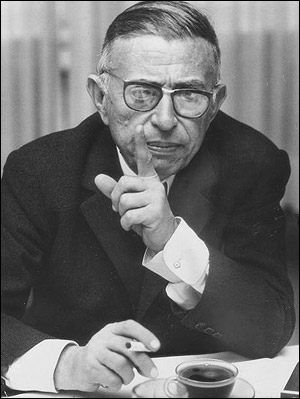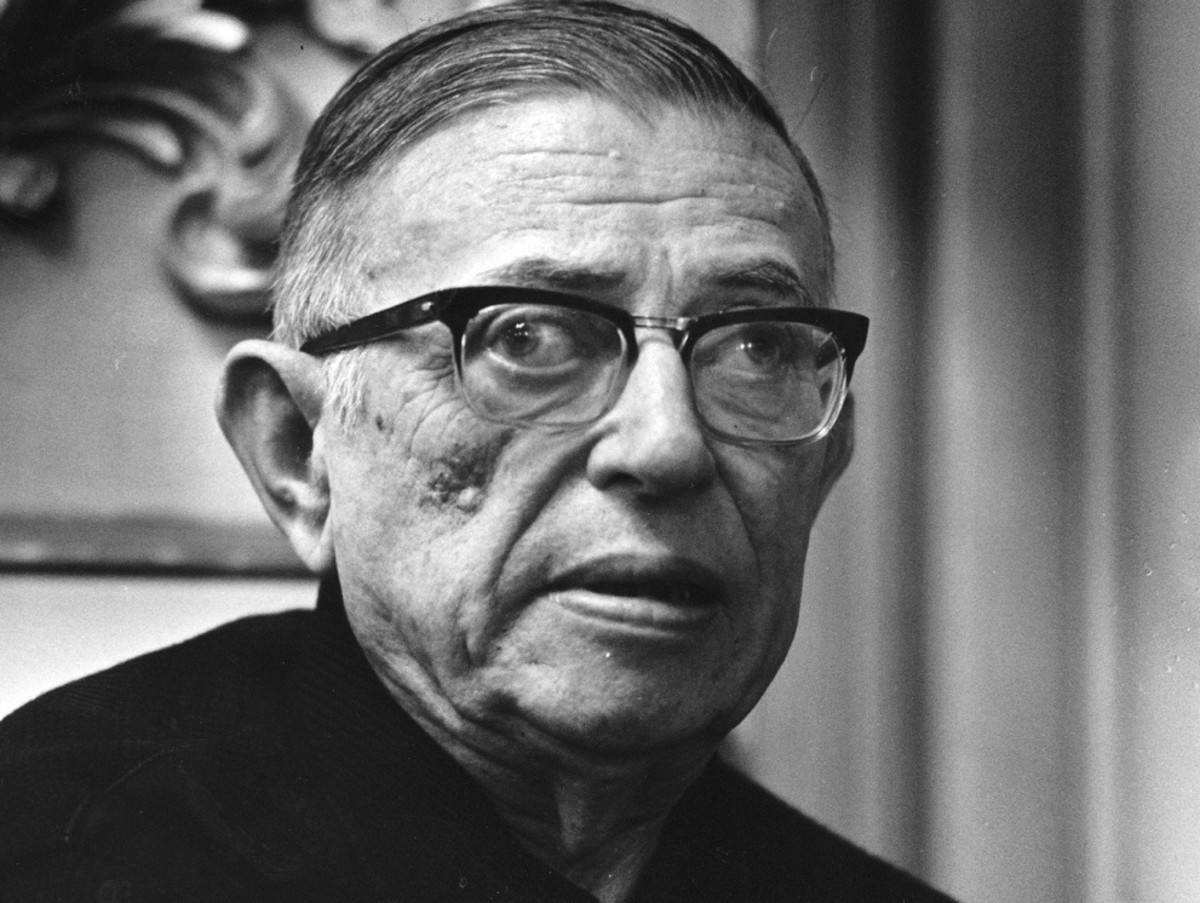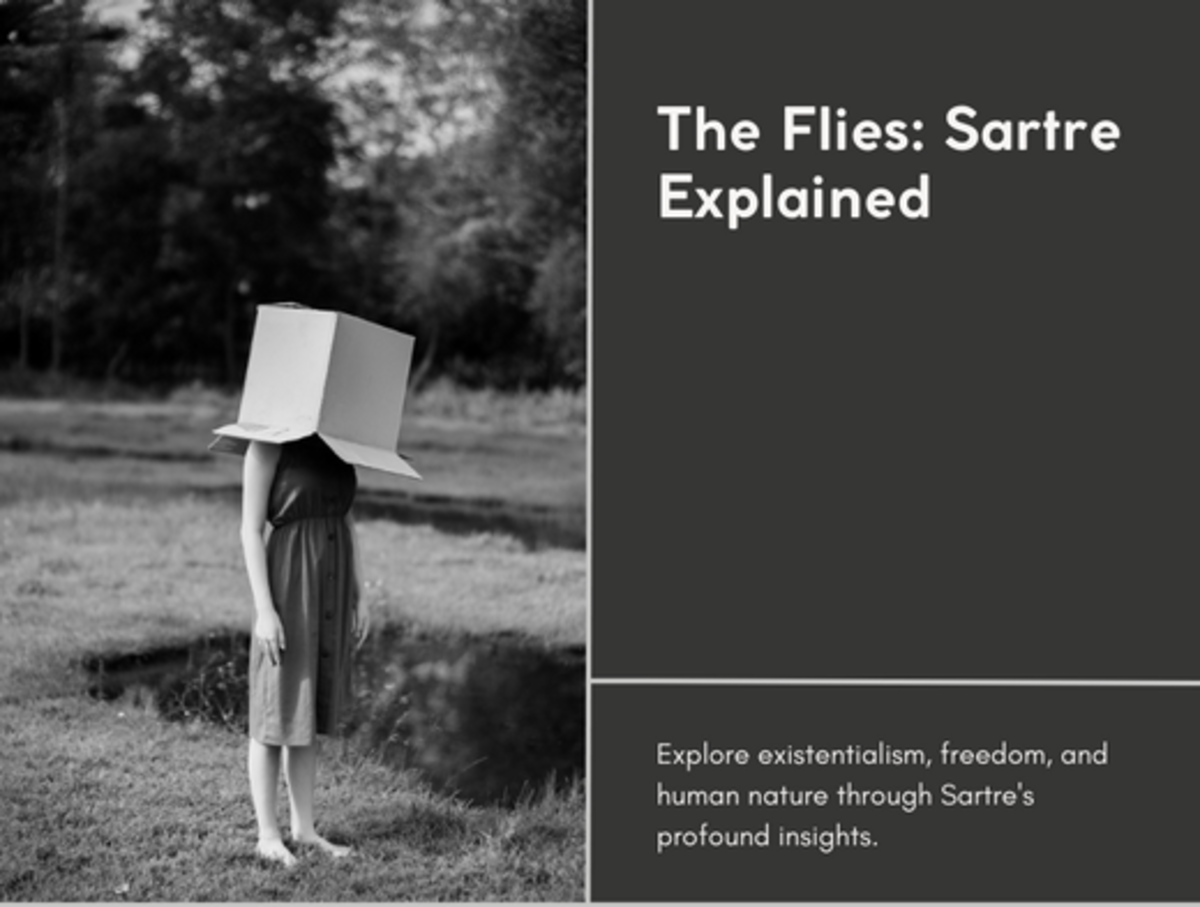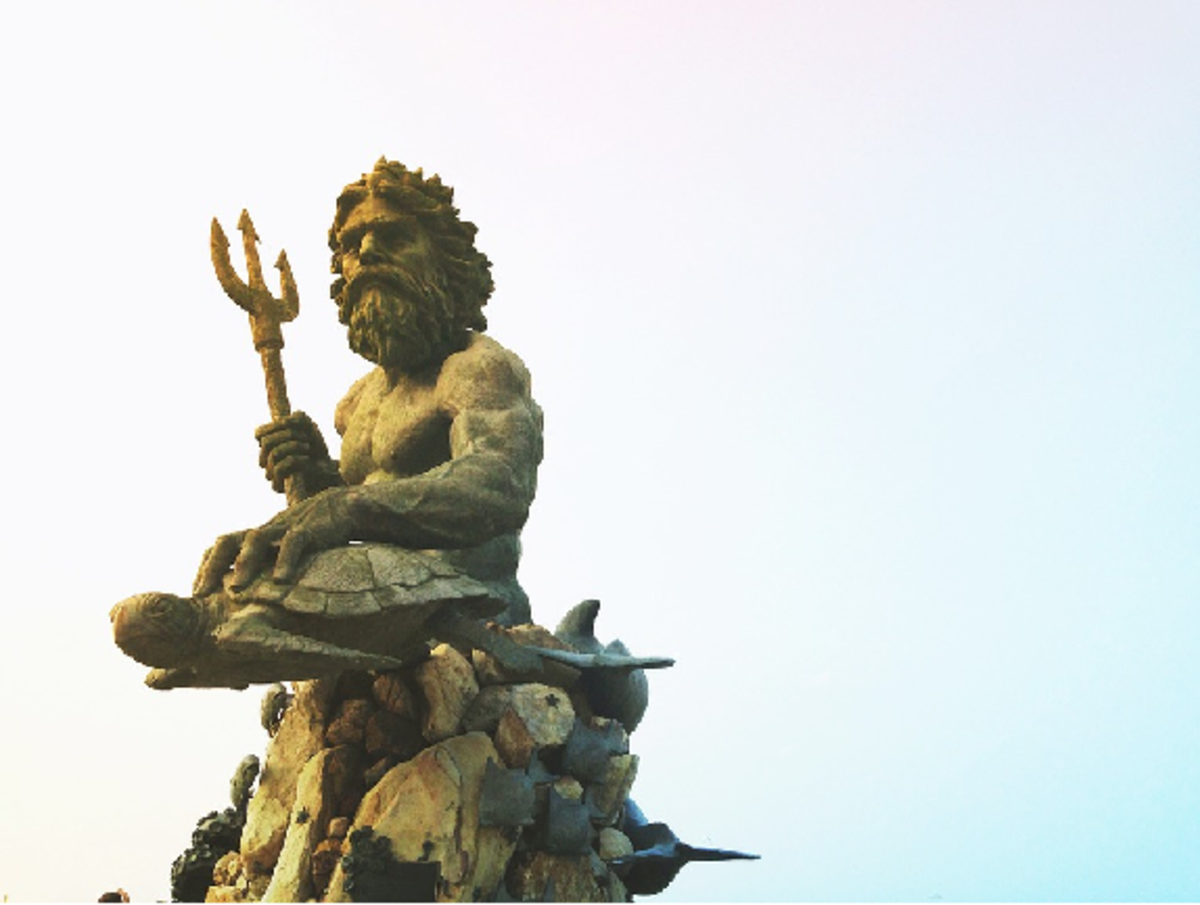Jean-Paul Sartre: The Existentialist

Jean-Paul Sartre (June 21, 1905 - April 5, 1980)
One of the best known philosophers of the twentieth century, Jean-Paul Sartre has a unique approach to philosophy. Known as the father of existentialism Sartre wrote many essay’s, plays and books that expressed his existential views. Jean-Paul Sartre had an eye ailment, was a soldier and prisoner of war. None of these obstacles hindered the literature and philosophical views that Sartre published. Sartre views existentialism as a fundamental way of living that includes owning our existence, shaping our own essence and taking responsibility for our actions. Jean-Paul Sartre’s life, experiences, views and works are well known all over the world. The child, the man, the soldier, the prisoner, the writer and philosopher, Sartre was an interesting man and one of my favorite philosophers. Early in life Sartre runs into obstacles at a young age.
Jean-Paul Sartre, was born Jean-Paul-Charles-Aymard Sartre in Paris, France on June 21, 1905 (Bloom 199). Sartre’s father died two years after young Jean-Paul’s life began. Jean-Paul Sartre and his mother move in with her parents where he is raised Catholic by his mother and grandmother in Meudon, France (Bloom 199). The fact that he was raised Catholic interests me because Sartre is known to be an Atheist in his later years. Around the age of four years in 1909. Sartre suffers from an eye ailment. He suffers from Leucoma in his right eye. “Leucoma is a dense, white, corneal opacity caused by scar tissue. A localized leucoma appears as a whitish scar surrounded by normal cornea. A generalized leucoma involves the entire cornea, which appears white, often with blood vessels coursing over its surface. Visual impairment depends on the location and extent of the leucoma” (http://medical-dictionary.thefreedictionary.com/leucoma). This ailment doesn’t slow down young Jean-Paul Sartre. After moving back to Paris, France in 1911, Sartre teaches himself to read from his grandfather’s library (Bloom 199). His grandfather held education in a high regard. Sartre disappoints his grandfather at the young age of 9 years. In 1914, Sartre’s grandfather hires private tutors (Bloom 199). His grandfather wanted to make sure his young grandson Jean-Paul got the best education as possible. Ann Marie, Sartre’s mother, pick up again and they move to La Rochelle, France.
After their move in 1916, Sartre studies at Lycee de la Rochelle one year later. He studies there from 1917 to 1919 (Bloom 199). He then moves back to Paris, France in 1920. By this time, Jean-Paul Sartre is becoming an adult at the age of 15 years. When he moves back to Paris, Sartre passes the first part of baccalaureate exam (Bloom 199). Two years later he passes the second part of the exam. Two years after that he begins studies at the Ecole Normale Superieur (Bloom 199). Sartre studies there from 1917 to 1919. Jean-Paul, 15 years of age is still struggling with school. He writes his thesis, but fails his exam. Obviously Sartre’s skills leaned toward writing other than organized exams. He places first in exam score and receives aggregation in Philosophy (Bloom 199). The professor is born.
In 1931, Jean-Paul Sartre is appointed Professor of Philosophy at the Lycee of Le Havre (Bloom 200). He remains there for two years. After leaving Lycee of Le Havre, Sartre studies the philosophies of Edmund Husserl and Martin Heidegger while in Berlin, Germany (Bloom 200). Sartre’s works have been read. He’s on the path that leads to his legend. Jean-Paul Sartre has his first work, L’Imagination published in 1934 (Bloom 200). War is coming. Uncertainty for many lives in near future.
Germany invades France. Jean-Paul Sartre takes his opportunity to write while in the army. Sartre and Albert Camus edit an unground newspaper called Combat (Bloom 200). He is then captured and is taken for a prison of war. Sartre is taken prison June 21, 1940 and escapes in March of 1941 (Bloom 200). The following April, he starts the Socialism and Liberty resistance. As the war dies down, the resistance dies down. Sartre had a drive to experience and write about his experiences. There isn’t a doubt of that. He wrote an underground newspaper. He was held prisoner, escapes and begins a resistance group a month after his escape. In my opinion, Jean-Paul Sartre was a tough guy. Not only was he a tough guy, he was a writer and philosopher by heart.
Jean-Paul Sartre has written so many plays, essays and novels. A few to mention would be , No Exit, Existence Precedes Essence, The Age of Reason and Humanism is Existentialism. Those are to name a few. Jean-Paul was an Existentialist. “Existentialism - a humanistic philosophy stating that each person is responsible for forming his or her self and must free will oppose an uncertain, purposeless, and seemingly hostile environment” (Webster’s 247). Sartre was a unique voice for that generation. For example, his play No Exit (1944) is about three people, a man and two women. The three of them are taken to this castle type place and put in one room together. They can’t open the doors or control the lighting. There is two chairs and one bed in this room. The three main characters: Garcia (male), Inez (Female) and Estelle (female) know they have died. They all believe that they are in hell or in another dimension after death. This play deals with morals, truth, seeking truth, finding truth in yourself, taking responsibility for your truths. “Look here! What’s the point of play acting, trying to throw dust in each other’s eyes. We’re all tarred with the same brush” (Sartre 16). Sartre, with this statement said that we were all equal. We come from the same species. This play has a dark comedy edge while being a philosophical, psychological emotional mind thrill. The topic of sex comes up. The fact that they’re all in agreement that they’re dead, the character feel freedom to do as they please. They don’t act on any animal instincts physically, but the psychological and philosophical are shown to be a human instinct. There isn’t any mirrors in the room. This gives dialogue for conversation about themselves. “It’s a trap. They’re watching you, to see if you’ll fall into it” (Sartre 30). This quote shows paranoia and suspense. Sartre’s taking a look into the mind. “That’s right! That’s right! Trust away! She wants a man – that far you can trust her – she wants a man’s arm round her waist, a man’s smell, a man’s eyes glowing with desire. And that’s all she wants. She’d assure you you were God Almighty if she thought it would give you pleasure.” (Sartre 40). This is an example of Sartre questioning morals and ethics. The ending of the play is on the humorous dark side. They all finally to come an agreement. “So this hell. I’d never have believed it. You remember all we were told about the torture – chambers, the fire and brimstone, the ‘burning marl’. Old wives tales! There’s no need for red-hot pokers. Hell is – other people!” (Sartre 45). They all laugh and come to an agreement so they can find their salvation to get out of hell. They realized that they need each other. This play shows Existentialism through the eyes of three people in this play. I was very impressed.
Another notable work is an essay, Existence Precedes Essence published in 1946. He suggests that Existentialism is, “the least scandalous , the most austere of doctrines. It is intended strictly for specialists and philosophers” (Minton 192). Existentialism is a humanistic philosophy stating that each person is responsible for forming his or her self and must free will oppose an uncertain, purposeless, and seemingly hostile environment. This essay suggests that we must exist first and through experience, character development and the things we do in life gives us our essence. Sartre also wrote novels.
In 1947, Jean-Paul Sartre wrote a novel called The Age of Reason. This novel shows Europe in 1938 rushing toward war. Sartre depicts the intellectual coming of age a generation. The players are tormented by the immediate problems of sex, overdrinking, and overthinking. They debate the merits of fascism and communism while they watch the coming of World War. They also struggle with the issues of individual and national liberty. “It’s true, it’s really true: I have attained the age of reason” (Sartre 397). This is the last line in the novel. This work of Sartre’s makes one look into the self. Jean-Paul Sartre wrote many other works. One of his most famous works, Sartre regrets ever having in print.
Existentialism is a Humanism was a public lecture delivered to a Parisian crowd October 28, 1945. The transcript of this lecture was the only print that Sartre openly regretted seeing in publication (http://plato.stanford.edu/entries/sartre/). Jean-Paul Sartre was an interesting human being.
In 1964, Jean-Paul Sartre refuses the Nobel Prize for literature feeling that it would undermine the meaning of his literature (Bloom 203). He also refused the one million dollars awarded along with the Nobel Prize. Sartre is awarded and accepts an honorary doctorate from Hebrew University (Bloom 203). Jean-Paul Sartre dies in Paris, France April 15, 1980.
Jean-Paul Sartre lived an interesting life. His views on existentialism are spread wide in his writings. His childhood wasn’t conventional. He strived in school at a young age. He overcame an eye disease. War comes and Sartre is drafted, writes an underground newspaper, gets taken prisoner, escapes and begins a movement. His life and works speak for themselves. Just reading some of his works and accomplishments makes me want to read more of his works and existentialism.
Works Cited
Bloom, Harold. Modern Critical Views: Jean-Paul Sartre. Philadelphia: Chelsea House,
2001. Print.
“Existentialism.” The New American Webster Handy College Dictionary. 3rd Ed. 1995.
Print.
Minton, Arthur J. and Thomas A. Shipka. Philosophy: Paradox and Discovery 5th Ed.
New York: McGraw – Hill, 2004. Print.
Sartre, Jean-Paul. No Exit and Three Other Plays. New York: Vintage International
Edition, 1989. Print.
Sartre, Jean-Paul. The Age of Reason. New York: Random House, 1947. Print.
Stanford Encyclopedia of Philosophy. Jean-Paul Sartre. 2011. (http://plato.stanford.
edu/entries/sartre/).
The Free Dictionary. Farlex. Leucoma.








